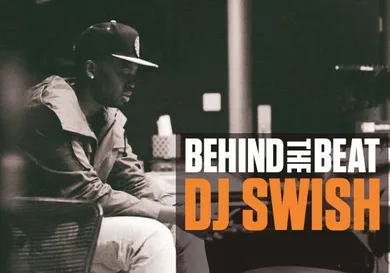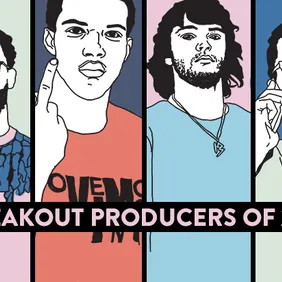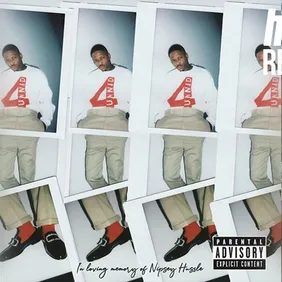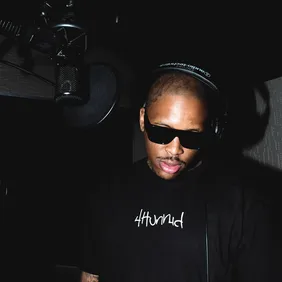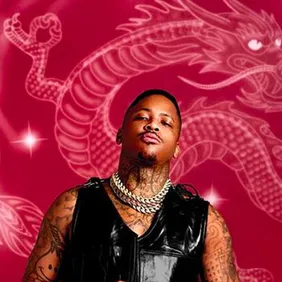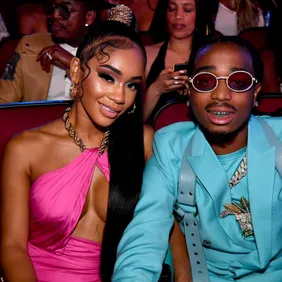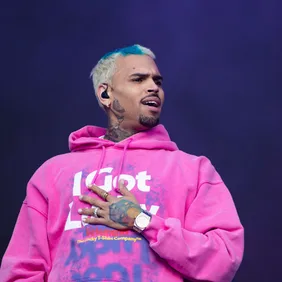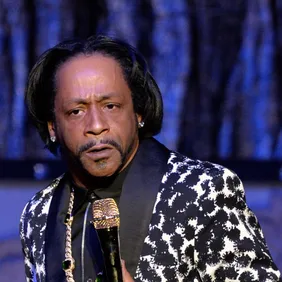During the beginning stages of recording his sophomore album, YG had a falling out with his longtime collaborator DJ Mustard, who produced the majority of his game-changing debut album, My Krazy Life. He quickly began searching for talents to fill the void. On June’s Still Brazy, the productions come strictly from Californians, including Terrace Martin, Ty Dolla $ign, Hit-Boy, and the lesser-known DJ Swish -- far and away the album’s most active collaborator, contributing to a total of six songs.
Still Brazy is darker and more focused than its predecessor, intended to reflect YG’s mind-state during the span when it was recorded. Looming over much of the project is the paranoia resulting from the night he was shot and hit three times at the loft that housed the studio where he made Still Brazy. Swish was there that night.
“I’ve been around shootings,” says the now-23-year-old producer, "But not as far as someone getting shot at, and being in the same proximity. That was a wild night.”
Later that night, Swish would finish a beat that would soon -- when YG marched out of the hospital the next day -- become “Who Shot Me?” A particularly placid sound compared to the rest of the album, YG used the instrumental to provide a chilling recollection of what transpired the night before, surveying the surrounding streets and catching glimpses of possible suspects -- ultimately left with more questions than answers.
Upon hearing YG’s recording, Swish decided to pick up the acoustic guitar and lay down a whimsical melody to give his tales an added air of reflection -- highlighting the deep layers inherent in the straightforward question being asked. “It kind of reminds me of an Italian mob story,” says Swish.
Swish’s precision in using an array of instruments in order to achieve various cinematic effects is what made him a particularly attractive candidate for Still Brazy. Born in Inglewood and raised in Lawndale, a small city in the South Bay region of LA, Swish gravitated to music at an early age. He started on the piano when he was six. "YG loves piano," he was quick to point out, and indeed, on their Still Brazy collabs, the Bompton rapper often structures his flows around Swish's simple, evocative piano melodies.
Throughout his adolescence, Swish played in the school band, jazz bands, and even a rock band. Along the way, he picked up a wide array of instruments, including the trumpet, the French horn, the flute, the guitar, and the drums. Upon hearing his music, his skills in the percussion realm are especially obvious. He'd probably still be playing jazz had he not discovered FL Studio.
“The day I found Fruity Loops,” he recalls, “I literally didn’t go to sleep. It was a school night, and I stayed up, went to school -- all I could think about was Fruity Loops. Got back, didn’t do any homework. I was on Fruity Loops for a long time.”
Fruity Loops provided his official foray into hip-hop, and he soon picked up DJing, eager to have his pulse on the music that people were excited about. At the time, YG and Mustard had just started to bubble and their signature style -- new-era party anthems with nods to the classic West Coast template -- ended up informing Swish’s own sound.
At one particular party, Swish was approached by a rapper known as RJ, who would soon become affiliated with YG and Mustard, as a signee of both 10 Summers and Pu$haz Ink. Swish told him that he made beats, and they immediately got to work, developing a sound that was driven by youthful energy and still decidedly West Coast. Swish produced several songs on RJ’s first mixtape, OMMIO, which was hosted by DJ Mustard. The tape's biggest song was “Ride Wit Me,” which was given “touches” by Mustard and thus his recognizable "Mustard on the beat, hoe!" too.
RJ kept Swish around for Rich Off Mackin, a collaborative project, released in January 2015, with Choice, another 10 Summers/Pushaz artist. The song “Get Rich,” which featured Iamsu!, would pick up major steam in LA, especially with the release of the video, which included a cameo from YG. It was a huge look for RJ, but Swish's contributions to "Get Rich" (and the rest of the tape) went largely unnoticed, as his tag was removed from the song and none of the credits were included with the release of Rich Off Mackin, save for its executive producer -- DJ Mustard. Swish was offered the chance to sign to Mustard, though he ultimately found it in his best interest to decline, as he had an unfavorable idea of how his talents might be used in the wake of his Rich Off Mackin experiences.
Though he hasn't worked with Mustard since, Swish had luckily already earned the attention of YG. Almost a year after its release, “Ride Wit Me” was remixed by YG, Nipsey Hussle, and K Camp, and later that year, a version without K Camp was one of the few songs used in YG’s “Blame It on the Streets” movie, during a scene when the 400 crew is driving en route to kill a pair of rival gang-members who had tried to do the same to them hours before.
Once Mustard was gone, YG knew Swish was capable of a reliable West Coast sound, and he told him of the direction he wanted to take his next album. Swish already had a gang of beats -- those with more subtleties and thus more suspense -- that he thought would suit his vision.
The first one he played for YG was “Don’t Come to LA,” which ended up as the ominous opening track after YG’s father's speech on the intro. "Don't Come to LA" stays mostly true to its title, as the danger of YG’s city seems alive but voyeuristically irresistible. “I remember him playing it over and over,” says Swish of YG hearing “Don’t Come to LA" during their first session together. “I was kind of excited ‘cause when he gets in the mode, he gets in it.”
Swish incites an enchanting spookiness using the gentle sounds of the harp and trembling chimes. Even with the many synthetic sounds within his workstation, he's always focused on trying to “dial that right texture to make it seem real.” “Even the harp [on ‘Don’t Come to LA'], I tried to make it sound real -- even though it’s a stock instrument.”
He's also responsible for arguably the most G-funk-indebted beat on the album, "Gimmie Got Shot," driven by a bare-bones bassline that sounds like all the sugar has been sucked out of one of Mustard's bass melodies. This one is something far more sinister. Horns punctuate the end of YG's most snarling punchlines, and the usual high-pitched frequencies set the scene in killer California. "You really gotta know the frequencies," Swish stresses, "And fill every spectrum of the frequency. It really colors the music."
The “Gimmie Got Shot” instrumental could’ve ended up on Doggystyle, and indeed, Swish made the beat with Snoop Dogg in mind, as there was an undisclosed artist who had a verse from Snoop in the stash that he wanted Swish to do something with. As he had done with most of what ended up on Still Brazy, though, Swish decided to hold onto the "Gimmie Got Shot" beat. “I saved it in case something good might happen,” he says. His patience paid off.
Working on Still Brazy enabled Swish to meet and collaborate with like-minded artists from whom he had much to learn. He assisted Ty Dolla $ign -- an unheralded virtuoso behind the boards -- on the ghoulishly gripping title track. And he had a hand in “Bool, Balm & Bollective” alongside one of his idols in Terrace Martin, a jazz-trained multi-instrumentalist who’s been one of the West's leading producers since linking with Snoop Dogg over a decade ago.
Martin instructed Swish to let his classical training take a back seat and learn to trust his basic creative instincts. “Just do it, just do whatever feels good,” Swish remembers being told. “He’s really been telling me, like, simple is good. You don’t have to add so much.”
Simplicity is at the core of what has proven to be the most important record off Still Brazy -- "Fuck Donald Trump" -- a rousing protest song that comes when the country needs good music of political consequence. The song's message is never far removed from its musical quality, boasting a smooth-riding instrumental built off a rework of a sample from the 1993 song "Fonky Expedition" by the Bay Area female duo Conscious Daughters. "FDT" has been particularly embraced in LA and the surrounding areas for its West Coast appeal, and it has motivated the local gangsta rap scene to become one of the most active hip-hop factions to rally against the dangerous GOP candidate.
“It really hit me once I started seeing other people saying, ‘FDT.’ I remember walking through Hollywood, and seeing a group -- I think Trump was coming through or something -- and there was a group of Hispanic people, and they all had ‘FDT’ playing, and I was like, ‘Hey, I did that song.’”
Upon producing a healthy portion of one of the year’s most talked about releases, Swish’s phone inevitably began to blow up. He had recently inked a deal with Universal before our meeting, and he said that the label was most impressed with his ability to venture outside of the West Coast sound -- into trap and even pop and EDM, not really seeing any genre as being unaccessible to his musicianship. “There are other avenues and genres I can attack,” he says. “I think that’s what’s making me more talked about now.” Chances are there's another YG out there looking to do something different with his next project. Swish'll have a pack ready.
